3 Marathons in 2 Weeks

Stepping it up Again
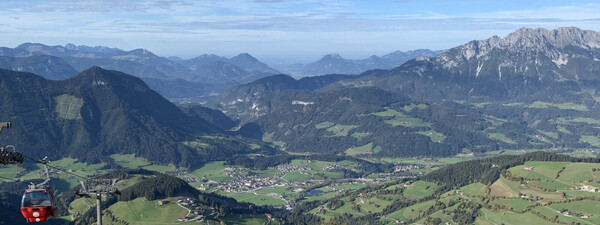
With the end of my initial EU capital challenge closing in, it was about time to do some training. Brussels, the final one of the 28 marathons, is right around the corner on October 28th, and I didn’t do a lot of running over the summer. Next to nothing, to be honest.
But I do know myself quite well, and if there’s one thing I can count on, it’s the signing up for races that gets me to train more adequately. Better yet, have some race before the races, so those function as training themselves. Spice it up with a new challenge and I’m good to go for my main EU challenge.
![“Yo dawg, I herd [sic!] you like challenges, so I put some challenges into your challenges so you can challenge yourself while you challenge yourself.”](/img/blog/3_marathons_in_2_weeks_rauchwart_kaisermarathon_tusem_baldeneysee/600/00_xzibit.jpg)
These three marathons I’m writing about rather happened by accident, though. Like this.
- Earlier this year, I signed up for the Munich marathon, October 14th, because I like the city and would like to visit again.
- My friend Jürgen’s marathon in Rauchwart, Austria, came back into my mind. Two weeks earlier than Munich on September 30th, it would be nice to have our families meet up again. So I signed up.
- Said Jürgen told me about the seemingly insane Kaisermarathon, a mountain race in Austria’s pretty Tyrol region, right on the weekend between both races. Naturally, we both signed up.
- I knew that all three marathons were fitting perfectly into my daughter Julie’s first school holidays, she’s in 1st grade now. So we built a family roadtrip style vacation around it.
- We realized that the drive from Munich back to Hamburg, which is about 800 kilometers, would be too much right after the marathon. Julie would be exhausted on her first day back at school the next day.
- So I followed another of Jürgen’s suggestions and changed the plan by replacing Munich with the TUSEM Essen Baldeneysee marathon near the city of Essen, Germany’s oldest continuously running marathon race. With just 350 km to drive after the run, that should be a lot easier for Sophie, our four daughters, and myself as well, as I do the driving usually.
I later realized that this Baldeneysee marathon, officially called “innogy Marathon” at the moment, would again be held on the day after the IRONMAN World Championships in Hawaii are televised in the night, which I really enjoy. That’s the third year in a row I’ll be running a marathon the night before it. So I’ve got another challenge on top of it all, which is running the third marathon within two weeks on just about four hours of sleep.
“Action beats inaction.”
As my friend Rasmus likes to point out.
Training
My most recent running race was Rennsteiglauf Supermarathon back in May, which is around four months ago. By my standards that is a huge gap. So I knew I needed to do something. A few short runs and a few long runs must do, as priorities concentrated around our sweet little Ida, born July 1st, of course her three big sisters, and my special summer project of building an insulated hut in our garden to practice playing the drums. (The hut is finished since and I’ll soon write about building it on my personal blog, teesche.com.)
So I’m hoping to count on good muscle memory and my base endurance of the last years to help me during the races.
Part I: Rauchwart Marathon
Rauchwart is a small town in the eastern part of Austria, not far from the Hungarian border. I ran the race in 2016, because it’s organized by my friend Jürgen. Our families get along great and we met quite a few times at different marathon events all over Europe, so why not start off the challenge in Burgenland!
To get there, we tried some new type of transportation, an overnight train from Hamburg to Vienna which has rooms with flat beds and also carries your car. It’s been quite a success, the six of us slept rather well and we were happy to continue onwards from Vienna by driving in our own car. Also, not too expensive! I recommend looking into this type of travel if that sounds like it might make sense to you.
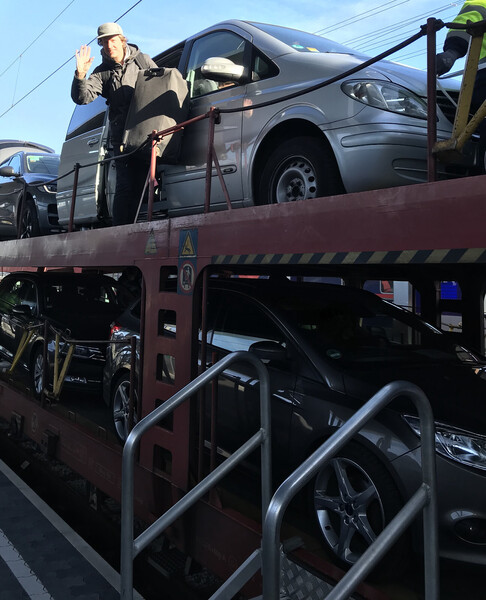
Another one and a half hours of sunny Austria’s streets and we arrived at Rauchwart’s lake.
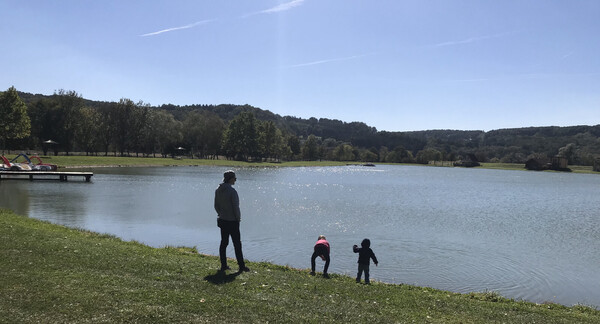
Jürgen, his wife Sonja, as well as his twin brother Harald arrived and started setting up tomorrow’s race. Jürgen made the decision to remove the side-events of a halfmarathon and a relay race in order to make it easier to organize the event. Around 50 runners had signed up for the whole marathon, the only remaining event, which is a number that Jürgen and his volunteering helpers were able to handle very well.
To prepare, I did what I always try to do, which is eat lots of pasta in the evening and lots of oatmeal in the morning before the run. We could easily walk the 500 meters from our rental apartment to the lake, which was perfect. At 9:57 AM we arrived, three generous minutes before the shot was fired, setting off the race.
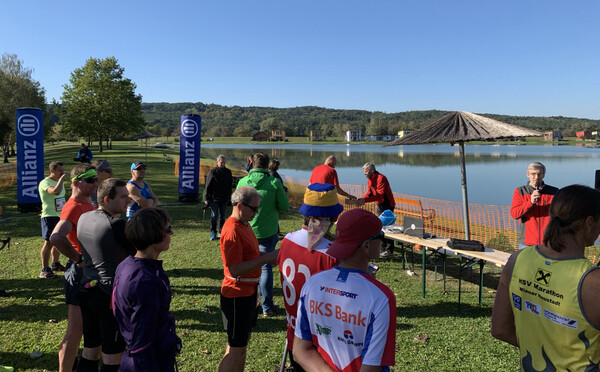
An International Event
And that’s just because of me! Every single participant was Austrian by birth, I’m the only foreigner. A fact which is acknowledged in the speech right before the start. Quite some attention on me right at the beginning.
The 42.195 kilometers were divided up into 9 laps around the lake and nearby area, making it 4.68 kilometers per lap. That way the event is a lot easier to handle for Jürgen. He just requires one aid station with drinks and a bit of food. I’m also happy as it’s a lot easier for Sophie and the kids to meet me multiple times during the race.
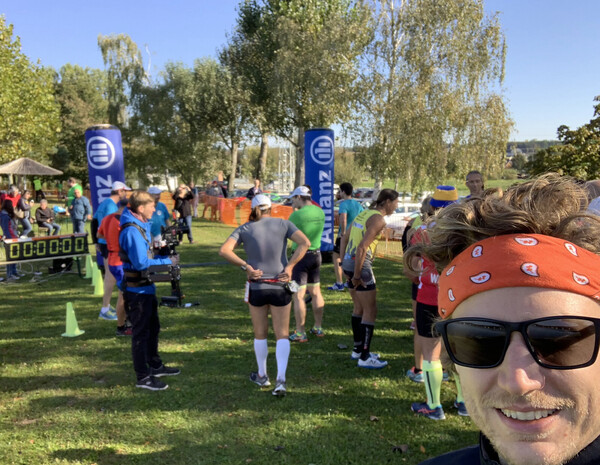
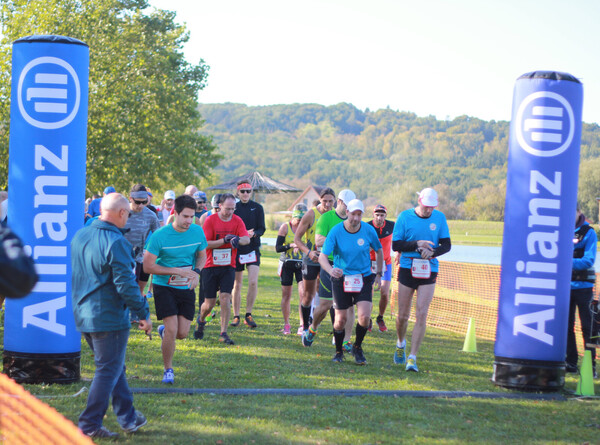
There seem to be no really fast participants today, although some start off quite a bit faster than me. The fun thing about such a small event is that you can get a good overview of who you’re racing with. It’s a lot more personal. Chances are, you’ll see every single person multiple times. I keep a pace of around 5:30 minutes per kilometer, which I’m able to handle rather well.
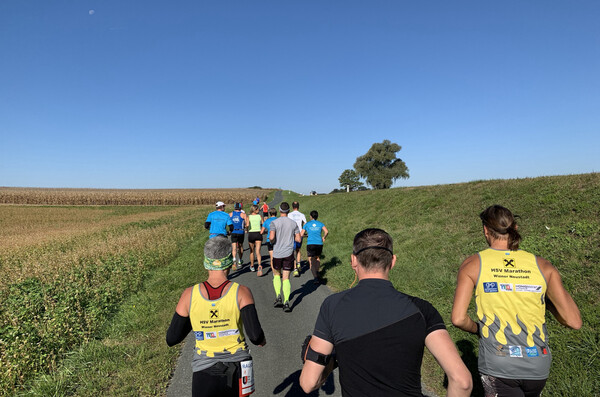
Talking to the other runners is always fun and interesting. I’m greeted by lots of them because I’m the only namely announced person as I’m the only non-Austrian. A couple I’m overtaking tell me that it’s her 49th and his 99th marathon. In two weeks they’ll have their double-anniversary at a Mallorca marathon. Not too bad!

At every lap I’m meeting the kids and unless they’re in the middle of playing or having lunch, they run towards me for kisses and hugs every time. I never mind the minutes I’m losing because of this.
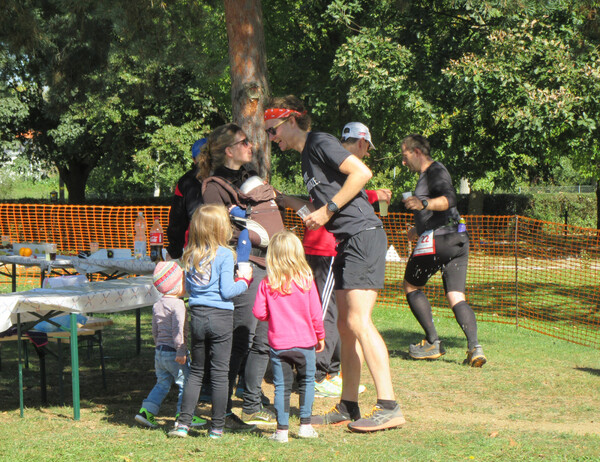
Halfway There
On my fifth lap, roughly around crossing the halfmarathon mark, the runner in first place overtakes me – so he is a whole lap, 4.68 kilometers, in front of me, or around 20 minutes. I’m surprised it happens this late. It really isn’t a fast race this year.
After 30 kilometers it starts getting a bit harder for me, put I manage to keep the pace. Some HoneyPower helps me right now!
At every lap, Harald, being the official announcer, looks at his tracking computer and says something about me. At some point he says I’m currently in 15th place. Overtaking a few others, I’m in 10th position later, which is very motivating. Also it’s fun to know your own exact position in the field while it changes. I’m briefly in the Top 10, but get overtaken again.
First Marathon Finish of this Challenge
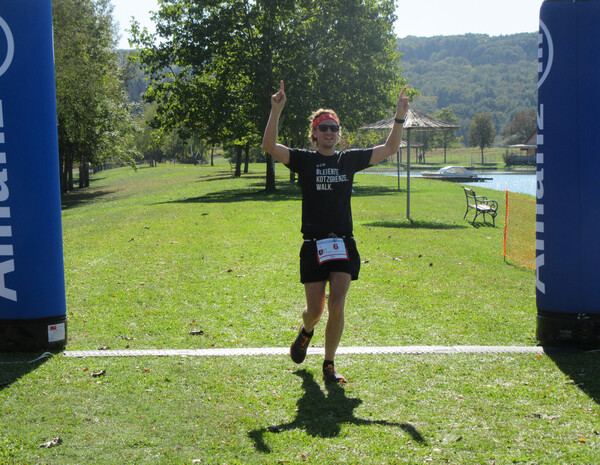
In the end I’m finishing 12th out of 41, quite happy about this. 3:47:20 hours is my official finishing time. Also nothing to complain about by my standards.
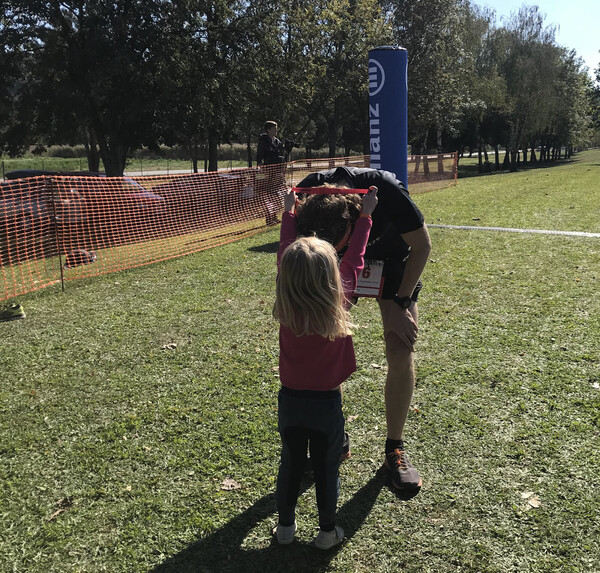
Time to find a spot to relax a bit. It’s not like this wasn’t exhausting at all for me. Laying straight in the grass by the lake feels very good right now.
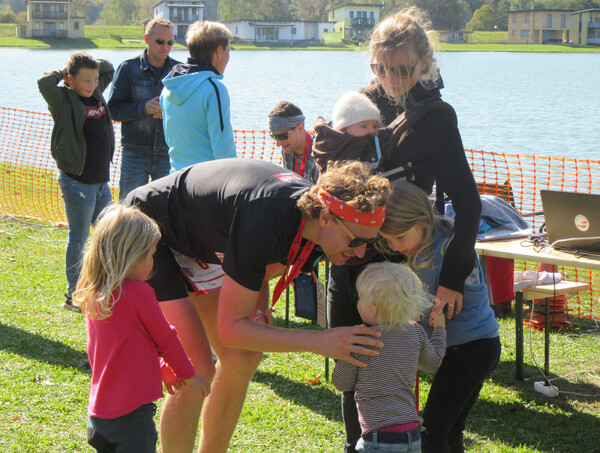
The race went very well, perfect conditions and organization by Jürgen, Sonja, Harald, and their volunteers.
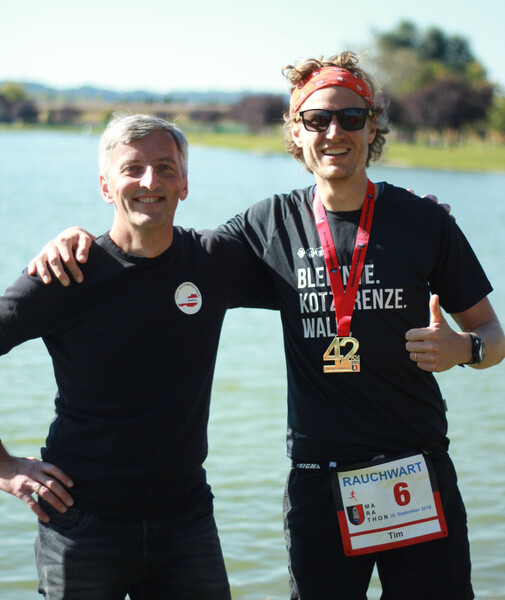
We stay for the winner’s ceremony and it’s fun to realize that, if, had I run my personal best time of 3:26 hours, I would have come in 2nd place today! Another reason to take up some speed training again and come back to Rauchwart. Standing on a podium some day in my life would be a nice goal to reach.
No blisters, no real physical problems, soreness of the muscles was also not too bad. Can’t complain. Off to the next one!
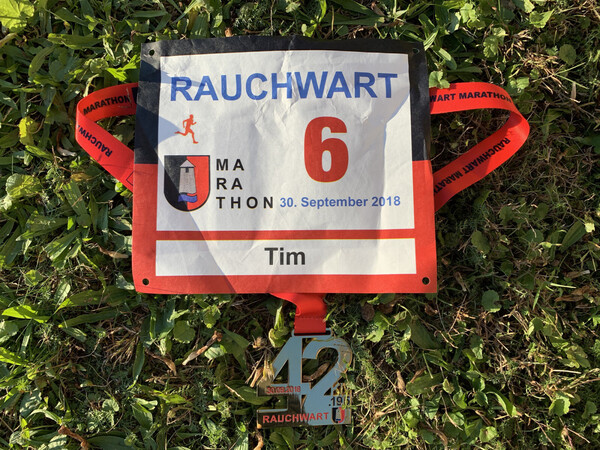
Some GPS watch tracking stats on Strava for the nerds:
The Tour de Tirol
The next race is the most difficult one of the three. It’s called Kaisermarathon and is actually part of its own three-race-challenge. Which I’m not doing this time, but it’s interesting nonetheless. So-called “Tour de Tirol” starts off on Friday afternoon of the race weekend with a rather flat 10k run around the hosting town of Söll. Flat, by Austrian standards, means 300 meters of elevation gain.
Participants get to catch some sleep before on Saturday morning, the bespoke Kaisermarathon will commence. This main event holds 2,345 meters of elevation gain over the classic marathon distance of 42.195 kilometers. Starting in Söll at about 700 meters above zero, ending at the mountain top “Hohe Salve” at about 1,830 meters. Insert nervous scream here.
As if that wouldn’t be enough on its own, on Sunday right after that, the event closes with a 23 kilometer trail round course that has 1,200 meters of elevation gain. In total, it’s advertised as 75 kilometers with 3,500 meters upwards over the course of three days. Gasp.
I mean, I had done a 74 kilometer run on one day, but that one “just” went up 1,800 meters. For a flatland Tyrolean, as we northerners call ourselves, the elevation gains are the main challenge, but also part of the attraction.
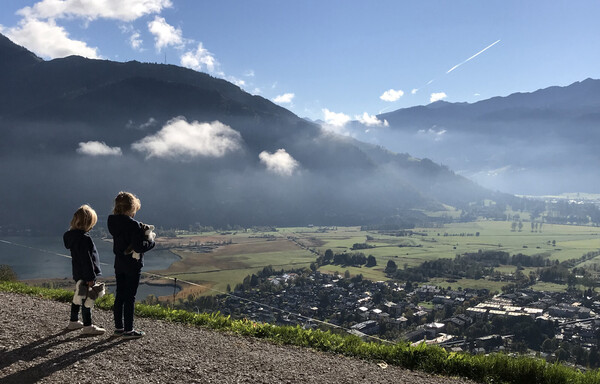
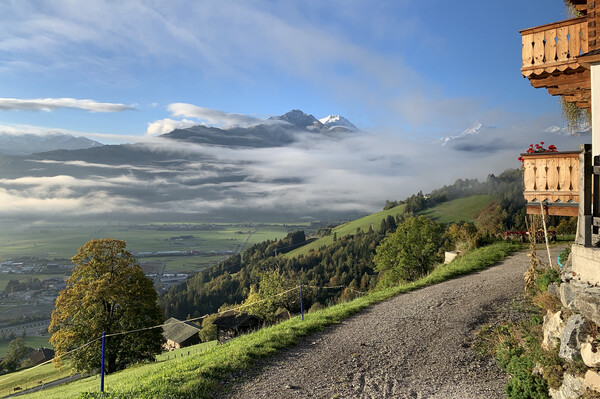
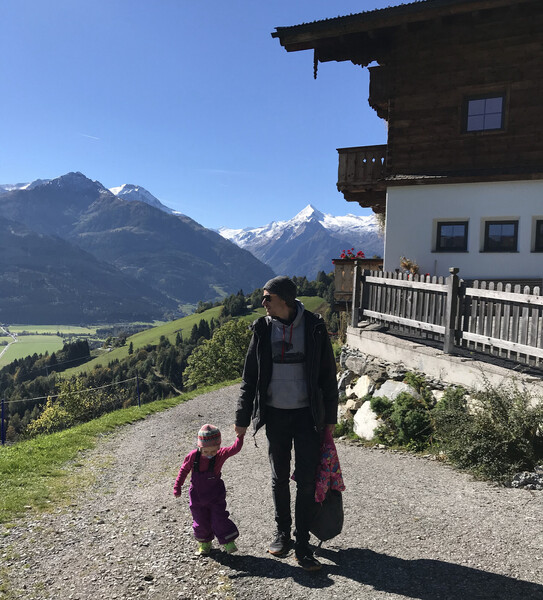
The Shoe Problem
Because of its difficulty, the Kaisermarathon makes it mandatory for every participant to carry a certain set of items. An aluminium foil blanket, a whistle, gloves and a warm beanie hat, but also trail running shoes with a tread depth of at least 3 millimeters. Well, I don’t own trail running shoes. And up until the event I thought this was surely not necessary. I got through the Rennsteig Supermarathon with standard shoes, why shouldn’t I get through it here? But I wasn’t sure.
So I asked Jürgen, who had done a few trail and mountain marathons before, for his take on the matter. And he strongly advised to get trail running shoes for this race. Okay. I trust his judgment. So I tried to find size 48 trail running shoes in the small Austrian towns we went through. Some unlucky tries later, I arrived here:
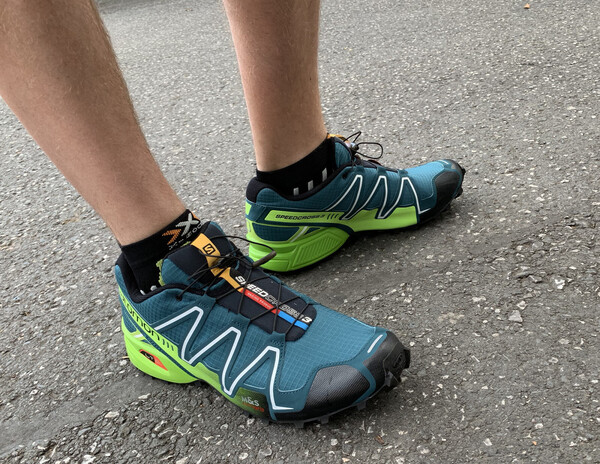
And so, I was about to make one of the worst mistakes every inexperienced runner can ever make: run a marathon in new shoes. It’s going to be blister-paradise, usually.
I did a 11k run around the Zeller See to at least break them it a little bit, and sure enough arrived with three new blisters. I never had trail running shoes before, and they feel like skiing shoes to me. Thick and heavy, stiff and tough. I trust them to get me up a mountain without slipping, sure, but at what cost to my feet?
Toughen up, just get through this!
I wondered if I would be able to enjoy the run while having pain at every step starting right from the beginning. So the nervousness-excitement mix shifted more towards nervousness in the days leading up to the race.
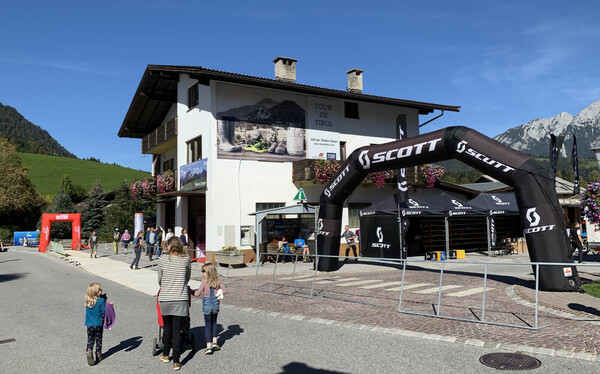
I even considered packing the worn-in street shoes into my running backpack and take them up the mountain with me, to be able to switch shoes whenever necessary. But then I had another idea. I put the internal soles of the street shoes into the new trail shoes. That should help a little, I hoped. One last test run on the evening before the event confirmed slight betterment. I also had two huge special blister bandaids with me, which I intended to put on the two mainly affected areas on my feet. After that, I can just hope for the best!
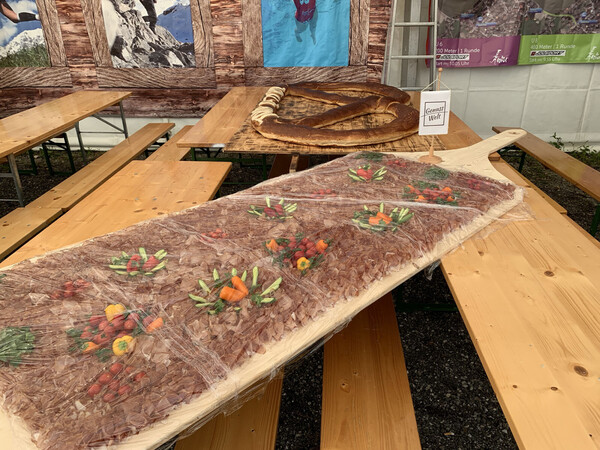
Part II: Tour de Tirol’s Kaisermarathon
Sunday morning, day of the race.
On the walk over to the starting area we accidentally came by the hotel that Jürgen and his three girls Sonja, Alina, and Bianca, were staying in. They saw us, waved from their second story window, and Jürgen threw down a marker for me to write my bib number on all the gels I intended to bring onto the race course.
It’s another mandatory thing here I really liked. That way, all the discarded rubbish gel packaging could be collected and the careless runners who threw it away would just be disqualified immediately. We need to preserve this beautiful place. I never understood the runners who just throw their rubbish everywhere, additionally being disrespectful to the volunteers that way. Not that hard to hold on to it until the next disposal station is within reach. Good going, Kaisermarathon people!
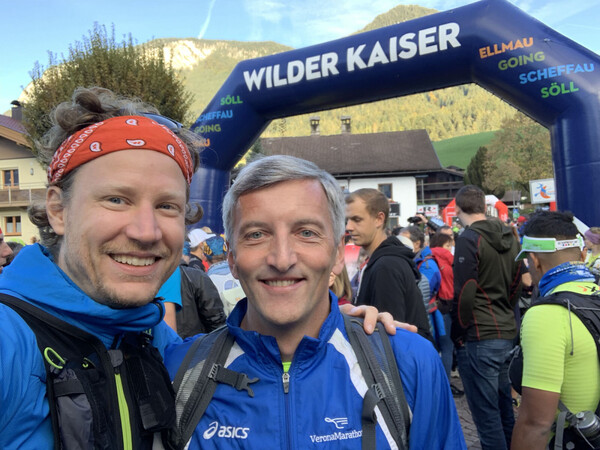
About 600 people were eager to start this tough run, which is quite a bit more than I expected. Many of them do the whole Tour de Tirol, but a big chunk was, like us, here for the main event.
To be very honest, I hadn’t really done my homework. I knew very little about the race. Not out of arrogance, but more because of a shift in priorities. I had made up my mind that whatever this race is going to throw at me, I’m going to find a way to get through it. So it wouldn’t be important for me to know exactly at which kilometer another steep incline was going to happen. The total of 2,345 meters of elevation gain gave me a good idea of the struggle lying ahead. There would be some walking necessary. This isn’t going to be a personal best marathon time type of situation.
This new mindset actually improved the experience for me. It all came as a surprise I could enjoy. I didn’t have many expectations, so I wouldn’t measure reality up to the picture in my mind. I could just be in the moment – which is the best thing about running.
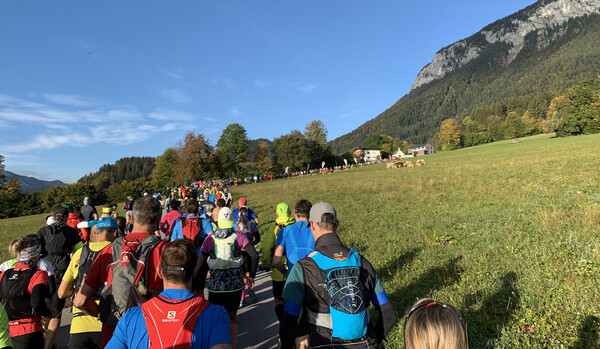
As the shot was fired, I couldn’t see pros sprinting off into the distance, but rather noticed the slowness of the masses. Everyone knew it was going to be wiser to start slow. Someone said the first 7.7 kilometers were supposed to be “kupiert”, an Austrian word I had never heard of before. Apparently it means “slightly hilly”. Very apt description. Good enough to warm up!
Talking to Jürgen and a few other runners took away my mind from my feet and the shoe situation that caused nervousness. I got into a very relaxed state of mind. Happy to be running.
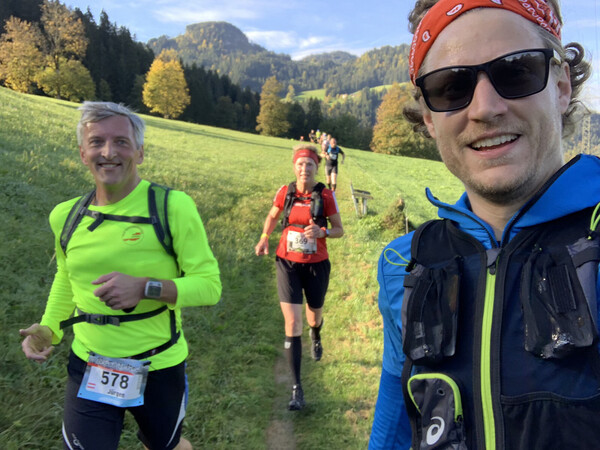
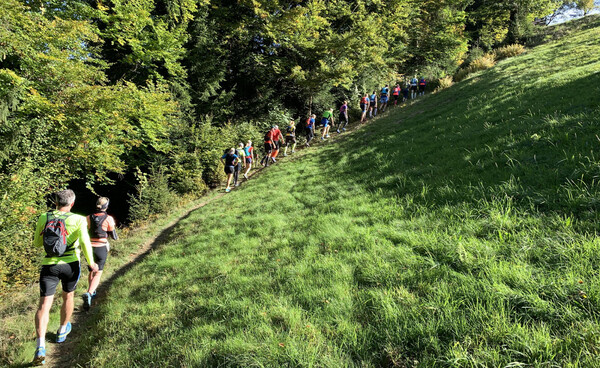
The weather and nature were just perfect. Between 15 and 20 degrees, blue skies and no winds. Absolutely the best possible conditions. The course now got harder, the trails a bit tougher. Very early on I realized that my shoe choice was the correct one. Even if I will end up here with huge blood blisters, it would still be better than my street running shoes. Those would not have gotten me the necessary grip at these steep ascents and descents. I would probably have injured myself on way too many falls.
Jürgen tells me about the other mountain marathons he did. The toughest one being the Andorra trail, which took him 11 hours for “just” the standard marathon distance. Yes, elevation plays a role!
We keep it slow in order to save up some energy for later. I know very little about the height profile, but I do know it ends on top of a mountain and the last few kilometers will be the hardest.
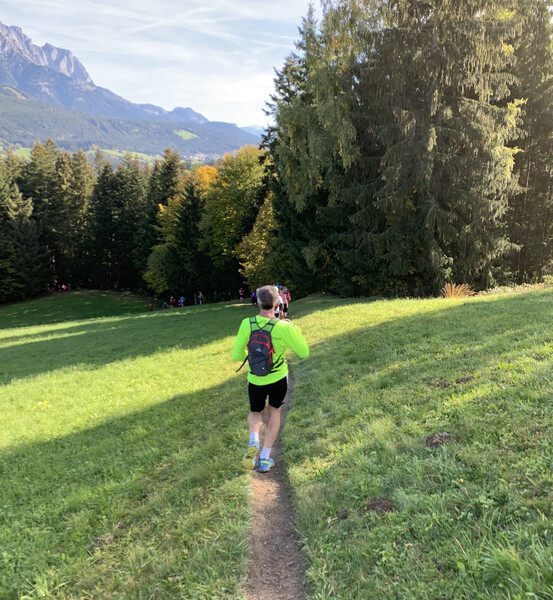
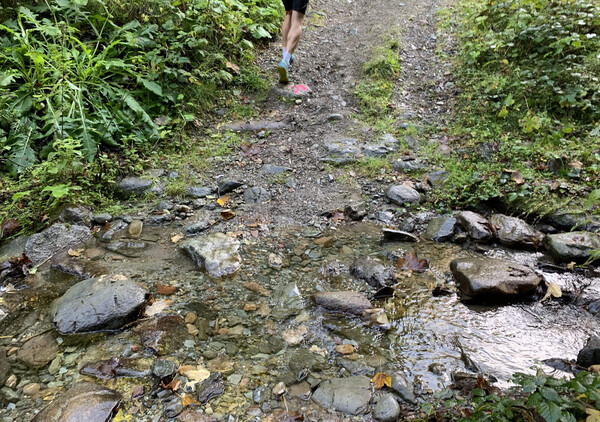
This race has lots of friendly volunteers at its 9 aid stations. Those stations are also perfectly organized and we always stop to have a small chat and give thanks while getting in some more water and electrolytes.
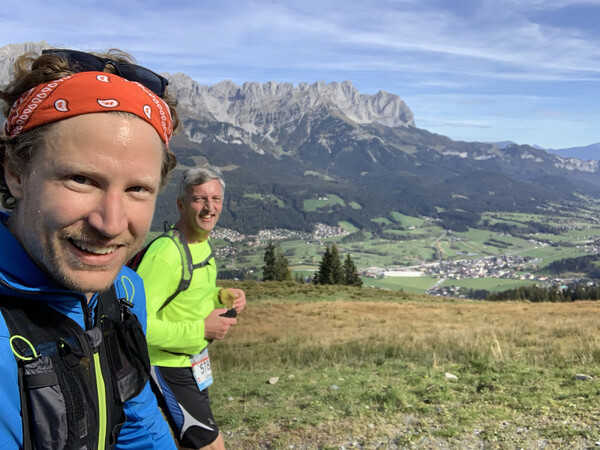
The air is slightly thinner, the sun burns a bit more, we have clearly come up a bit. Jürgen reaches his 5,000th marathon race kilometer here at the half marathon mark, it’s his 119th full marathon race. The guy has got some experience! We stop for a short photo op to commemorate this occasion. I’m at number 43 today, somewhere around 1,800 marathon race kilometers.
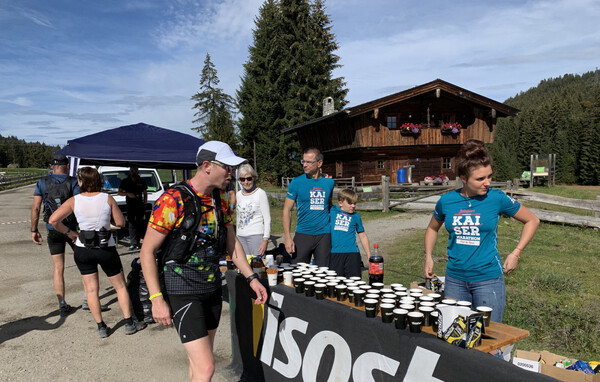
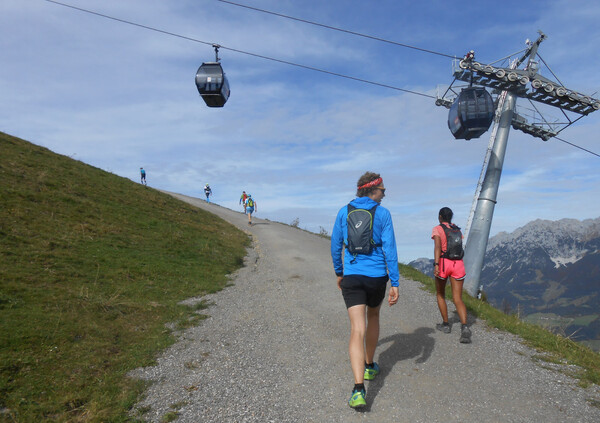
We’re at about 26 kilometers, still doing very good. Jürgen told me from the start that I shouldn’t feel obliged to hold his slower pace but rather run my own most comfortable race today. Up until now I did just that by keeping his pace, incidentally. But here, I feel I’ve got some power suddenly. I want to run faster. So I take him up on his offer and see where it will lead me.
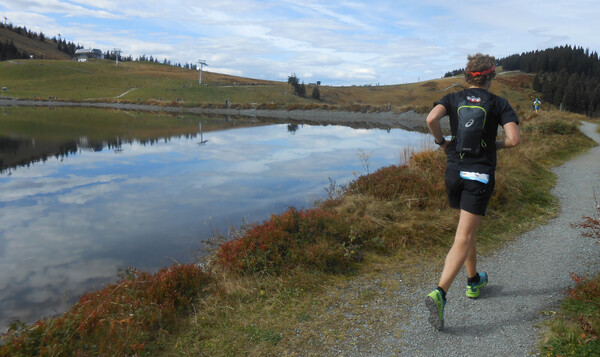
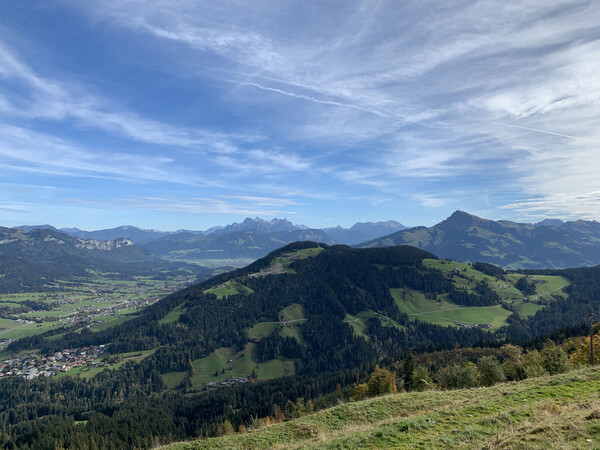
It’s just very lucky I get to do this. It’s becoming more and more clear to me the older I get. Also, I’m incredibly glad I gave up smoking when I run up these hills here. Wise decision, to no one’s surprise.
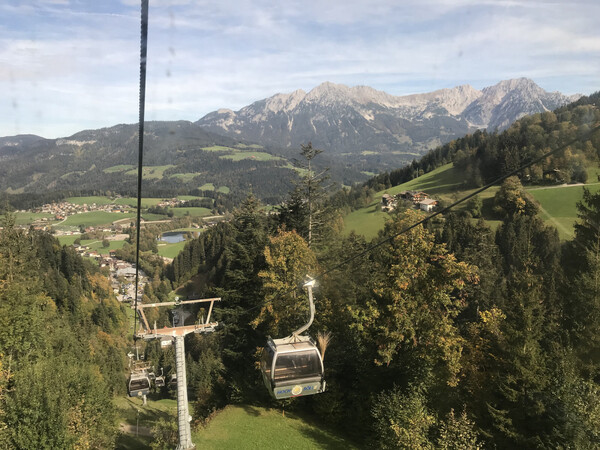
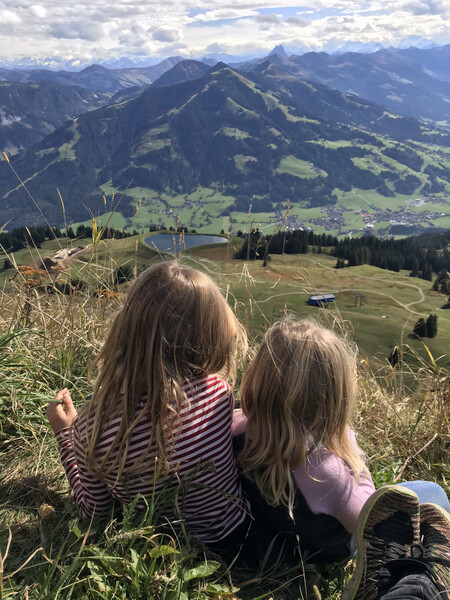
After 30 kilometers, there’s a rather steep and technical downhill path for about a kilometer. That’s also a bit new to me. It’s hard to concentrate on where to put each step after 30 kilometers of uphill running. And because of the slow total pace, including quite a few uphill walks, the field is now so stretched out I can see no one else and have to pay attention to where the course is leading, as well. This feels great, much like a solo adventure. I make a mental note to do more mountain trail running later in life.
On some of the paths I meet hikers and tourists and everyone is very cheerful and impressed. Nice feeling, too. Nothing can beat those breathtaking panorama views, though. They just don’t stop motivating me.
Kilometers 32 to 35 are quite tough, I am slow and feel some of the energy leaving me. But then, I reach so-called “Hexenwasser” station, a small activity village, centered around nature and kids, also functioning as the end of gondola #1 and start of gondola #2, which in turn will end at the top of our goal mountain. This is half-way up, so to speak. But the best thing about it is I get to see the kids! On some meadow, Julie and Vera appear out of nothing and run towards me. Holding hands, we run along the course together until we reach Sophie, who is there with Emma, Ida, and also Jürgen’s wife Sonja. I’m obviously excited to see them and as always, they provide me with a huge motivational boost.
The Big Fight Against Gravity
So I have collected some more energy to get me through these toughest 7 remaining kilometers. I’m really looking forward to the experience.
I had no idea.
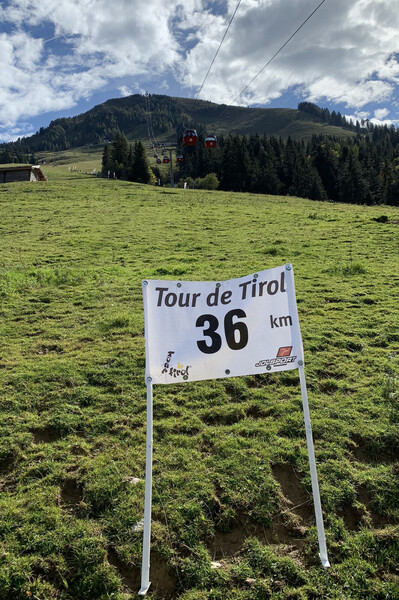
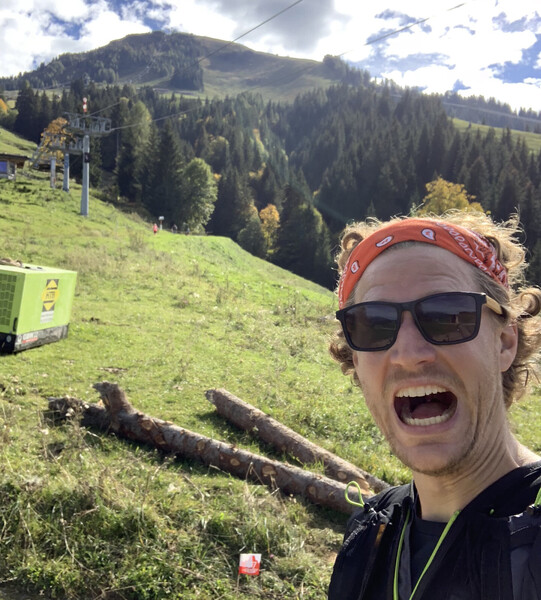
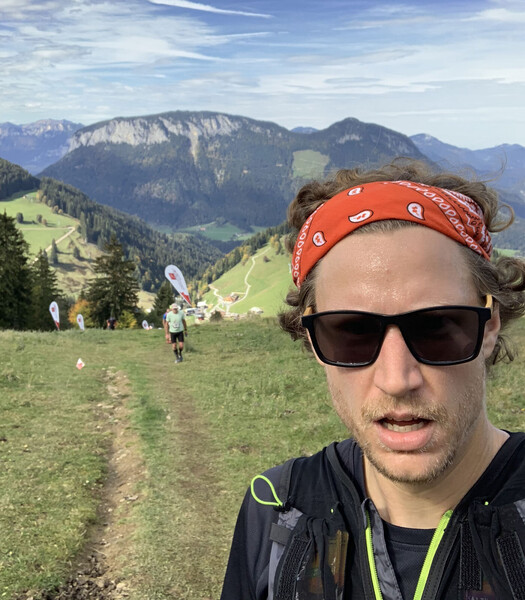
AC/DC knew what’s up when they recorded “It’s a long way to the top if you wanna rock ’n’ roll”. My German translation would be “von nichts kommt nichts” – which my father likes to say. Both very true.
This is such a steep mountain I can’t remember if I ever even did something like this in my life. It’s so hard I reach peak heart rate and stay up there by just walking at a zombie pace. Sweat just runs down my face and drops on the floor. It tastes a lot more salty than I’m used to. I need to keep watching my salt intake. The thin air and burning sun don’t make it easier.
I overtake a lot of “runners” here – no one is running. Many of them stand still in order to collect themselves and give the heart a break. Some sit down or even lie down to catch a breath. After all, we also have 36 kilometers in our legs. But I can continue. Very slowly, but I’m moving forward. Each step gets me closer to the top, a reassuring fact.
Then, I hear my name screamed across the meadow: the family is in a gondola again, on the way to the top, and they spotted me! Great, another boost. Keep going!
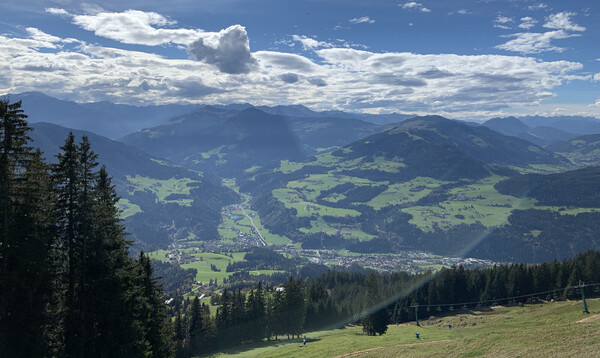
It takes such a long time to complete each kilometer. There’s an aid station at 37.5 which has a wisecracking volunteer kid saying to everyone “Just 5 kilometers left! But 400 meters up!”. That’s 6 times Hamburg’s toughest hill, Waseberg. I take a cup of water from him, put in a bunch of salt they offer, and down that stuff. Gets me going! And I know I needed it.
Funnily enough, the next few kilometers are flat. Running again feels nice. Catching my breath and decreasing my heart rate by starting to run instead of stopping is also new to me.
Suddenly there’s a sign, saying “40”. But according to my watch, 300 meters of gain are missing – is there a mistake? Or is it actually going to be 300 meters up on just the last 2 kilometers? Yes. Yes it is.
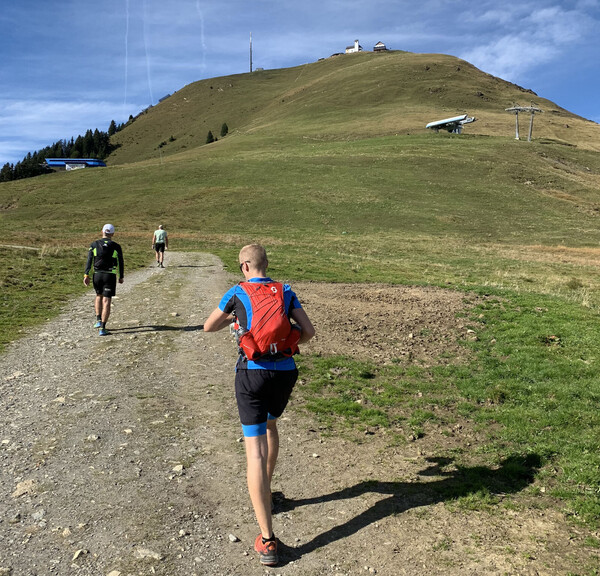
They even put up a 40.5 kilometer sign. Because they know how long it takes. This is quite a fight for me, but I like it. There are no more trees around here, we’re high up now.
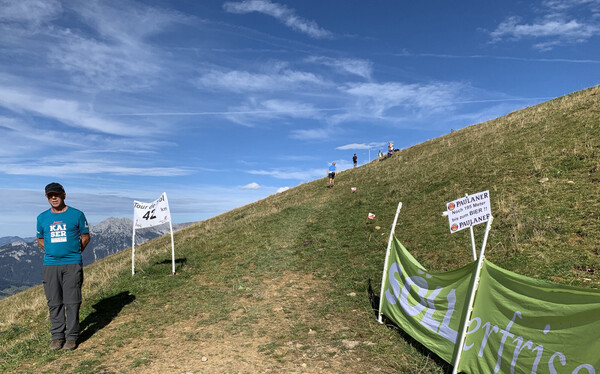
Toughest Last 195 Meters of a Marathon Ever
Even these last 195 are no joke. Almost straight up.
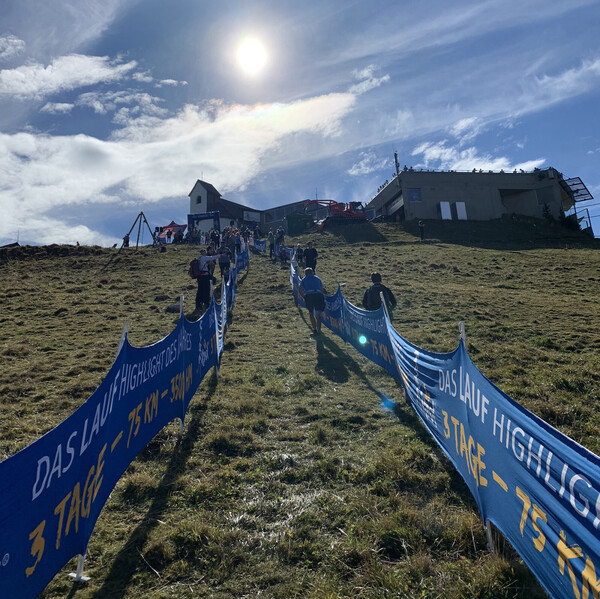
Crowds are amazing here, clapping, calling my name which is visible on my bib, high-fiving me.
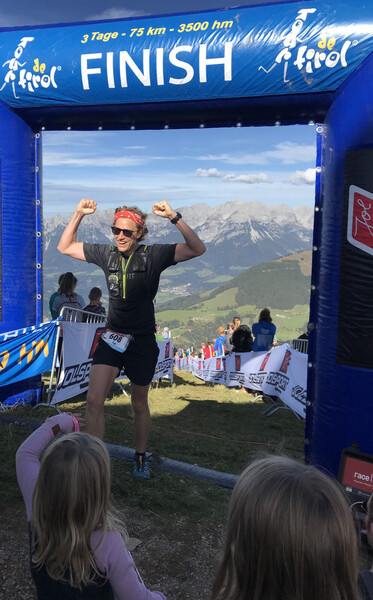
Vera again managed to be the one to hand me my medal, she’s so cool. I’m fighting with tears of exhaustion and happiness. What a race, just incredible. The girls are all here to welcome me. So happy. 6:29:57, longest marathon ever. But one of the best, maybe even the best.
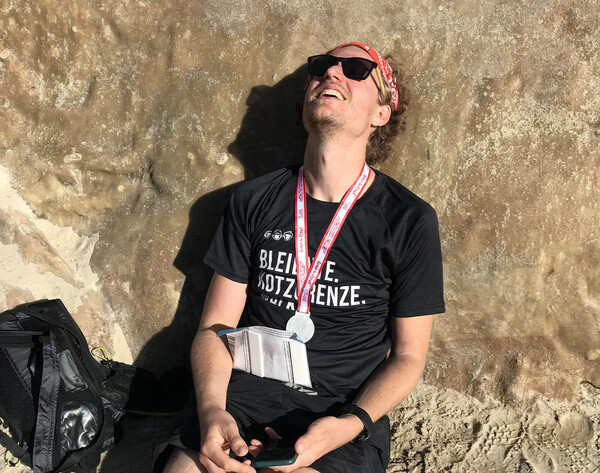
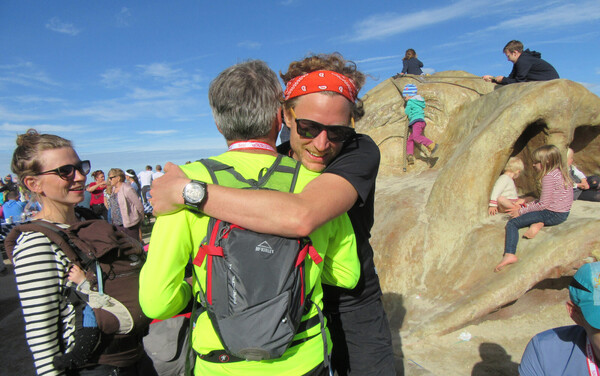
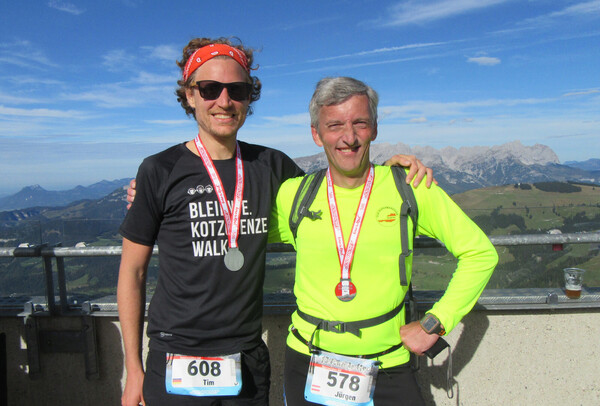

It’s great we can now just take the two gondolas back down and will be right in town again.
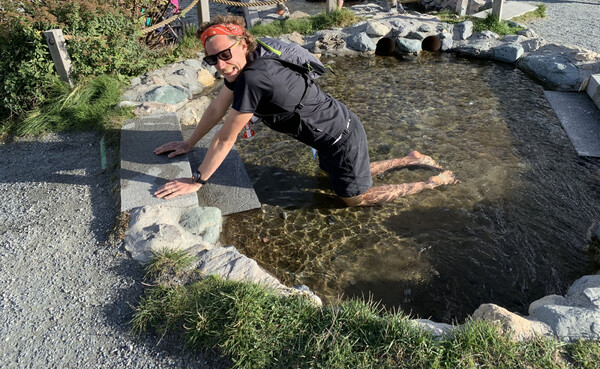
Weirdly, I feel stronger now than I felt before. Sure, I’m exhausted and couldn’t run this race again right away, but I somehow get the sense that this improved my fitness level. It’s been a good day. The rest of the day I constantly smile in my head. Probably also sometimes on my face.
Sophie said she had a great day with the kids during my running, which is a relief. Playing at the Hexenwasser station was perfect for them. You’ve got to hand it to the staff here, they did a very smart job. There’s nothing that went wrong from what I could see, and the whole family had plenty chances to enjoy themselves. I can recommend this race!
But you have to admit that we got really lucky with the weather conditions. Apparently there have been years in which the runners had to fight through deep snow. It would have surely taken us quite a bit longer.
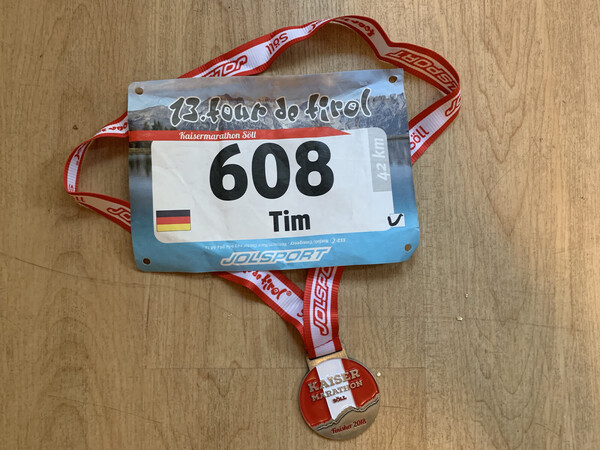
Also, here are my GPS tracking stats on Strava.
In the evening we’re meeting up with Jürgen and his three ladies to have some well-deserved pizza and beer. Both never tasted so good!
Part III: The Baldeneysee Marathon / TUSEM Essen-Marathon / innogy Marathon
The vacation continues, the recovery begins. First, I’m very happy I only got four new blisters and zero new black toenails. The blisters will probably not be a problem because I don’t need to wear my new trail running shoes anymore. That part of the experiment also worked out: running a marathon with new shoes is possible and not too bad on the feet.
Now we’re making our way back north into Germany. A day’s visit at Legoland Germany keeps the girls happy, and another stay at Heidelberg to visit an old friend makes us all happy.
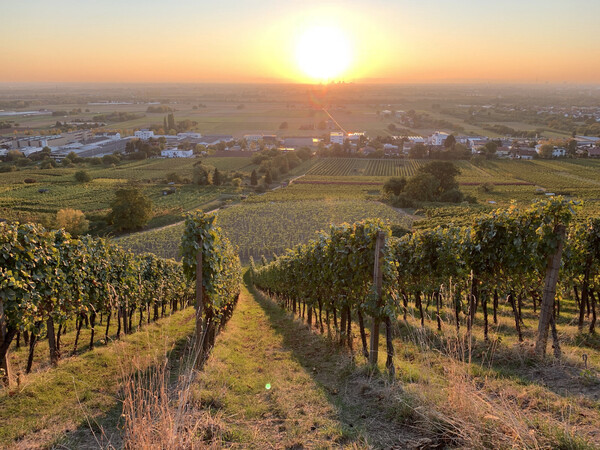
Apart from that, I do nothing special to make sure I can finish the third and last marathon of this challenge. A bit more protein maybe, a bit more water than usual to make sure the standard dehydration disappears, and that’s it.
This third marathon is a special one. Close to the German city of Essen, right in our busy and industrious Ruhrgebiet, there’s a quiet place around Baldeneysee, a recognizable lake surrounded by easy hills. It also has a calming aura to it and is a favorite recreational spot for people living in the area.
The marathon itself is Germany’s oldest continually held marathon race. 1963 it started, which is a lot later than Boston started (1897), but given Germany’s huge problems in the years between, the delay in marathon running affection is understandable. The race is also still organized by a standard sports club, not a profit-oriented company. The club’s name is TUSEM, which is why most marathon people know the race as the “TUSEM Essen-Marathon”.
This year, because of sponsoring, it’s called “innogy Marathon”, but it’s the same one. Leading twice around the beautiful Baldeneysee lake, with an additional little loop north to reach the full 42.195 kilometers.
As mentioned, an additional challenge for me in this race would be the lack of sleep against which I could do nothing at all. Yes, the IRONMAN World Championships in Kailua-Kona, Hawaii. Because of the huge timezone difference to Central Europe, the athletes I follow and admire would start their 3.86 kilometer Pacific swim during our evening time, and continue with the 180 kilometer bike ride and 42.195 kilometer marathon run well past our midnight.
Still, I just had to watch it live. There were a bunch of surprises this time, as heavily favorited Lionel Sanders and Sebastian Kienle both had big problems, Sanders with a weak finish as 29th, Kienle even dropping out of the race. But, in the end, I watched our Darmstädter Patrick Lange run everyone down and win his second World Championship title in a row, this time even breaking the magic 8 hour barrier here in Hawaii as the first human ever. Right after that, he proposed to his girlfriend in front of everyone. What a guy! It was worth it very much to stay up until 3 AM to witness this all unfold.
So, after three or four hours of sleep, I embraces a zombie-like look until I had a coffee and was ready to go. Thinking about Patrick’s incredible performance yesterday gave me goosebumps again and a big motivational boost for today. So, we’re all happily off to the starting line!
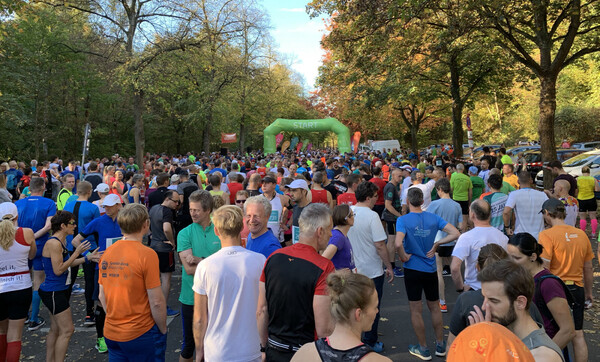
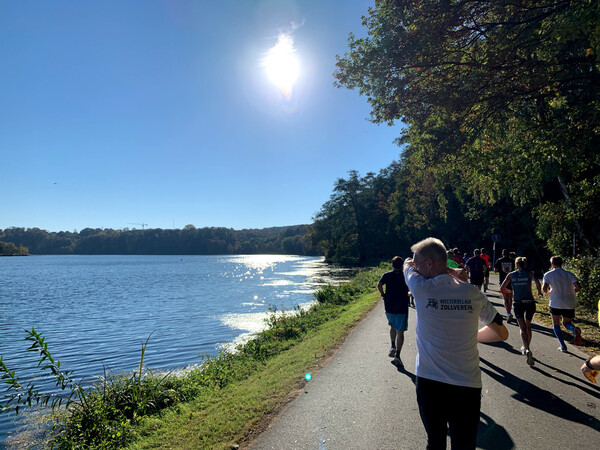
My recovery had worked quite well and I felt good to go for another marathon. Looking forward to it, actually. Again, the weather was unbeatable and I felt quite lucky that this plan of mine seemed to work out as well as it did.
I had a rough goal of reaching a sub 4 hours finishing time in the end, but first and foremost, reaching the finish line itself is most important to me.

I kept close to the 3:45 hour pacers, and that worked out alright for quite a while.
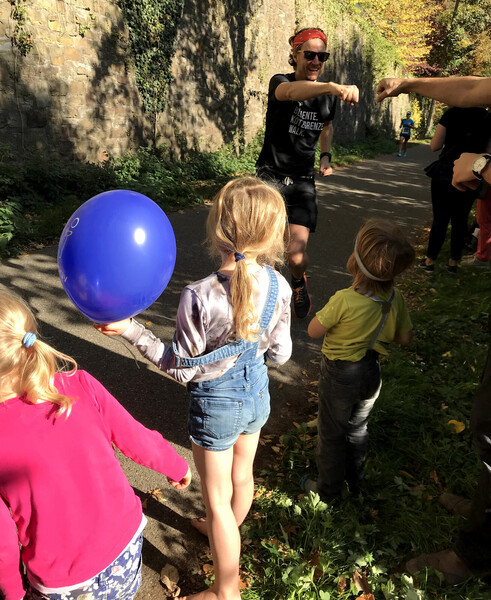
Again, some good friends were able to meet up with us. Franziska and Anselm brought their little Jakob and Anouk to enjoy this day at the lake with us. From their home in Münster it was just a minor drive to meet us here.
I could keep up the pace very well up until 39. Which is very far, I think. But at that point, I just had almost no energy left, suddenly. Not the type of energy that can be replenished with power gel or water, just a general feeling of fatigue. Thankfully, just 3 kilometers to go. I sadly watched the 3:45 hour pacers pass me by and collected myself to do some more slow running after a short walking break.
It worked out. And this race was also in the books.
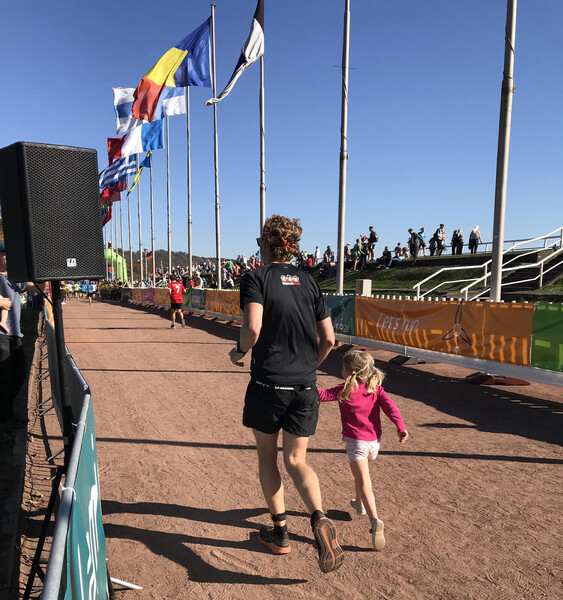
3:48:33 is also a finishing time I’m very happy about. Great flat and easy marathon, nice crowds, no complaints at all.
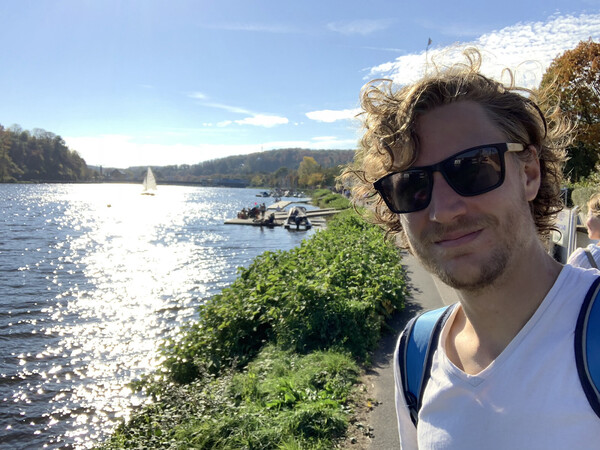
A quick shower, and off to the family to have another hour of late summer bliss at the lake.
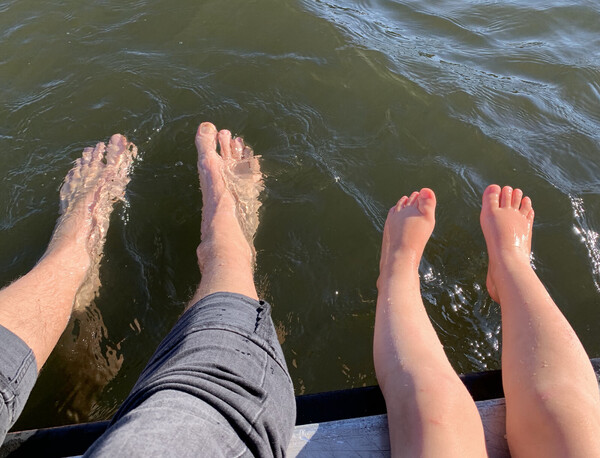
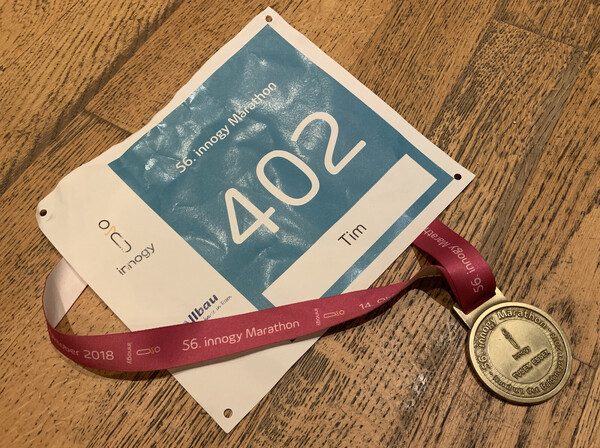
And, of course, my Strava tracking stats.
Challenge Completed! Brussels Can Come.
How do you feel after reading this?
This helps me assess the quality of my writing and improve it.
Leave a Comment